CyberPowerPC's Gamer Xtreme 4000: Now with Sandy Bridge
by Dustin Sklavos on January 4, 2011 12:00 AM EST- Posted in
- Systems
- Intel
- Sandy Bridge
- CyberPowerPC
- NVIDIA
Application and Futuremark Performance
We already know how powerful the Intel Core i7-2600K is on its own, but what happens when we take it up a notch? The 2600K purring at the heart of the Gamer Xtreme 4000 runs at a 4.4GHz turbo speed (kept nice and cool by the Asetek liquid cooler), and this is well beyond the overclocks on the other test systems we've used. The Xtreme 8500 and DigitalStorm BlackOps are both running their last-generation i7s at a still respectable 3.8GHz, but as you'll see that's nowhere near enough to catch up to the demon inside the 4000.

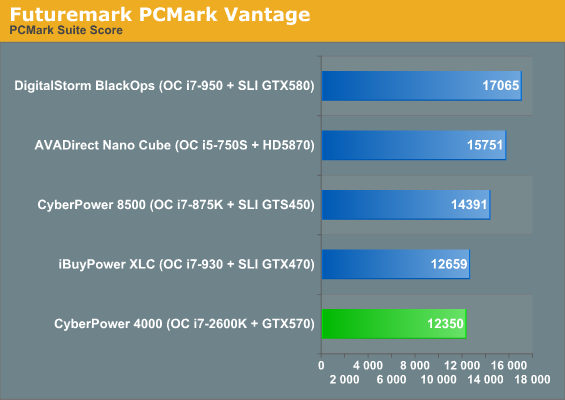
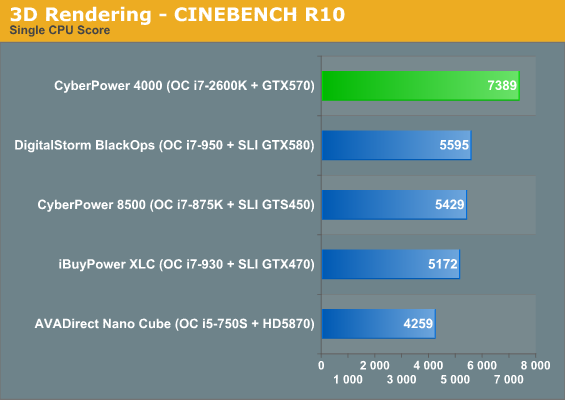
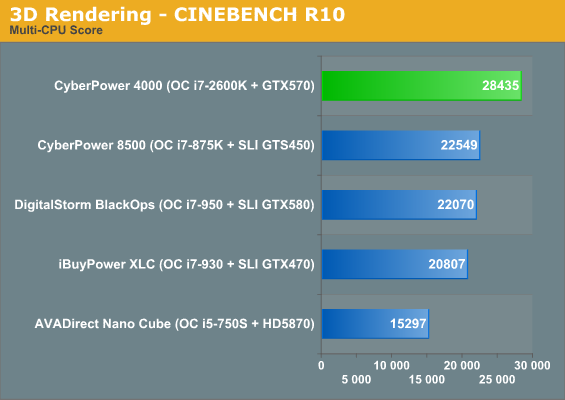
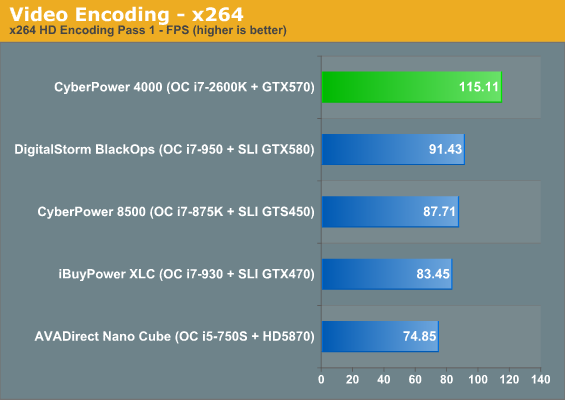
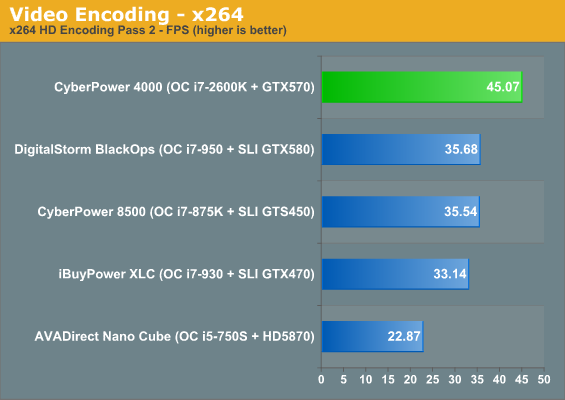
The PCMark tests are notoriously biased toward SSDs, and since all of the other test towers come with SSDs for the system drive the standard mechanical drive in the CyberPower 4000 can't keep up. Once you get past those tests, though, the overclocked i7-2600K blows by the other processors. They can't even put up a fight: a 600MHz clock speed advantage on a more efficient architecture is just too much.
Oddities in Futuremark benches don't just stop at the PCMark tests, though, as you'll see when we run the 4000 through our suite of 3DMark tests.
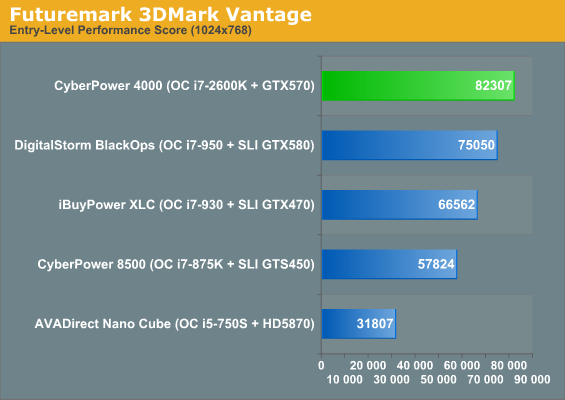
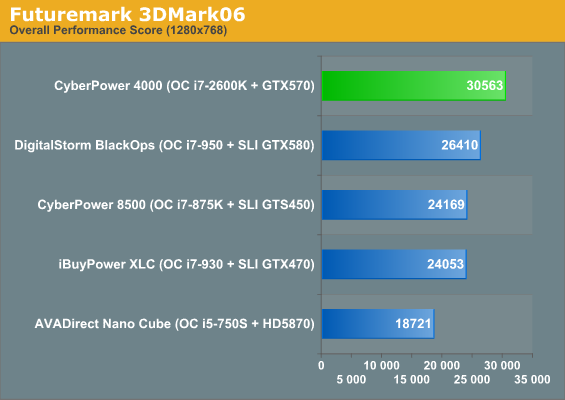

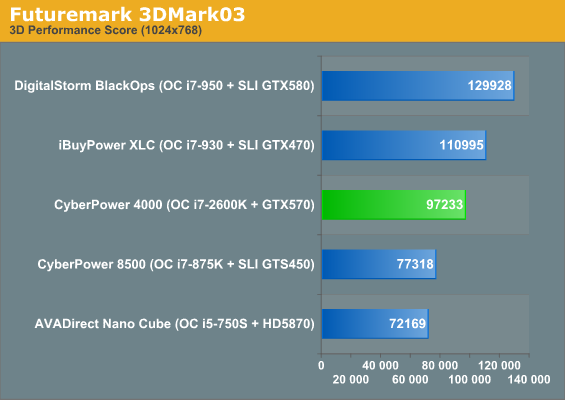
Amazingly only 3DMark03 proves not to be CPU-limited; in every other case the overclocked i7-2600K pushes the CyberPower 4000 past the other machines. When we move on to our gaming benchmarks, though, we'll see things start to fall in line again.










42 Comments
View All Comments
JarredWalton - Tuesday, January 4, 2011 - link
I believe the overclock applies to all the Turbo modes. So the 4.4GHz is for single-threaded, and you'd get lower than that for dual-core/multi-core operation. Intel didn't specifically list the Turbo states for the desktop chips (see my SNB Mobile article for comparison, where they explicitly list what SC, DC, and QC can Turbo up to), but if they do something similar to the mobile parts then you should still see up to ~4.0GHz even when loading all four cores.JarredWalton - Tuesday, January 4, 2011 - link
Edit: Okay, maybe this is the correct info from a different slide. Intel appears to state that on the desktop CPUs, Max Turbo is +4 bins for SC, +3 bins for DC, +2 bins for TC, and +1 bin for QC. That means if you set the Max Turbo to 4.4GHz, quad-core could still hit 4.1GHz (assuming temperatures are acceptable).Stuka87 - Tuesday, January 4, 2011 - link
Hmm, ok. Still seams a bit confusing the way they have it written. If its +1 but for QC, wouldn't that mean 1 bin up from the base clock? So if you over clocked the turbo from 3.8 to 4.4 thats effectively 600MHz, so 600Mhz over 3.4GHz is 4GHz?JarredWalton - Tuesday, January 4, 2011 - link
Yeah, that's what I'm not sure about. Can you raise the max Turbo for SC/DC/TC/QC separately? I don't think so, but I don't have any desktop hardware so I can't say for sure. It would make more sense to have the DC/TC/QC Turbo be Max - 1/2/3 in my book. I believe there's also some stuff in the BIOS where you can set the thermal/power range on the CPU (Ian mentioned this in the ASRock mobo review I think? Or maybe it was Anand's article....) I guess right now I'm stuck looking for information as well, while I long for SNB hardware other than the notebook I got. :-)cyberpowerpc - Tuesday, January 4, 2011 - link
Just to clarify some concerns regarding the OC:The 4.4 GHz OC is modest for Sandy Bridge. We could have easily shipped a 4.8/4.9 GHz system but feel that we did not want to ship a system with an Overclock that we, in the end, may not support.
Additionally, for the max turbo ratio, you can individually set what the DC/TC/QC turbo. In the review system, the max turbo ratio was set to x44 and that applies to DC/TC/QC.
7Enigma - Tuesday, January 4, 2011 - link
Thank you for the reply, but what you are basically saying is you chose a single (modest) multiplier and put it for all DC/TC/QC values. Why would you choose the same number when the thermals should be vastly different (ie DC multiplier should be significantly higher than the QC multiplier)?I think you just confirmed how basic this "OC" really was.
Stuka87 - Tuesday, January 4, 2011 - link
Thanks for replying. It clears up the question that I had regarding the various turbo speeds.However, why not set the turbo speed for DC to a higher level than TC or QC? It should be easily doable from a thermal standpoint, unless testing showed this to not be true and/or some other issue came up.
I understand not wanting to go too far and then not be able to support it, that makes perfect sense from your point of view. however.
MeanBruce - Tuesday, January 4, 2011 - link
Sandy-M LGA-1055 does seem amazing, yet for those who don't know Sandy-E LGA-2011 is due in July. Native USB 3.0, LightPeak support, the new X-68 chipset, Quad-Channel memory, integrated north bridge, now that's worth waiting 6months for! The enthusiast platform CPU, Mainboard, and Memory, should cost only $200 to $250 more, well worth the investment!JarredWalton - Tuesday, January 4, 2011 - link
I didn't think X68 (or whatever) was slated to get USB3.0, though I haven't really looked into that I admit. LightPeak might be nice though.strikeback03 - Wednesday, January 5, 2011 - link
According to Anand's article, SNB-E won't be until Q4, i.e. October at the earliest http://www.anandtech.com/show/4083/the-sandy-bridg...